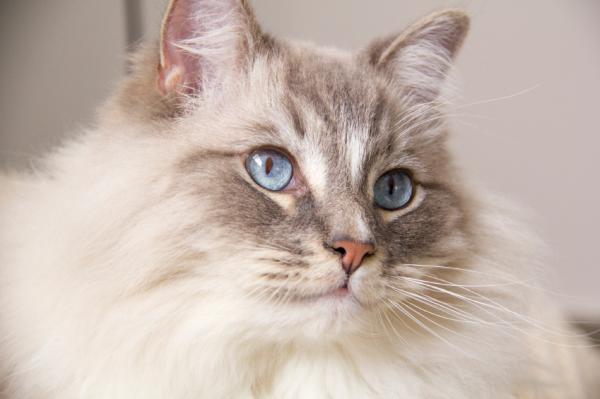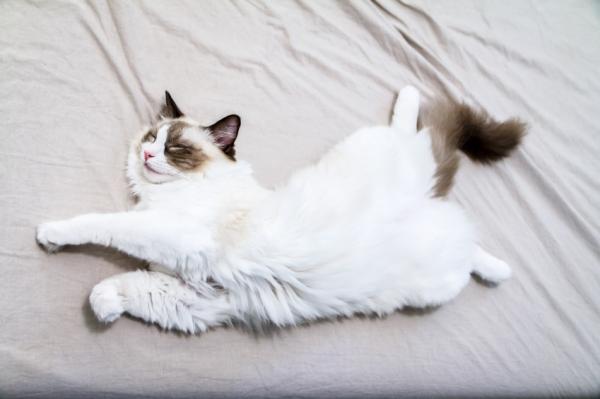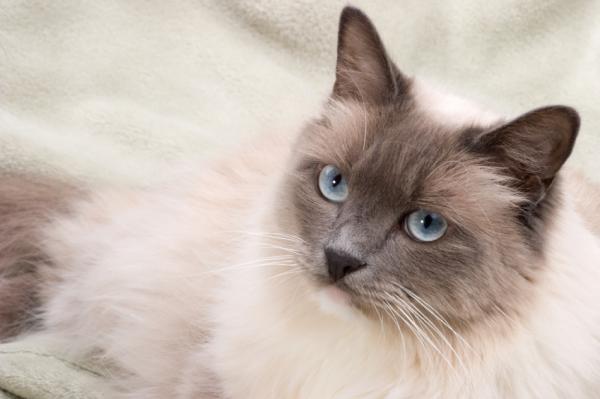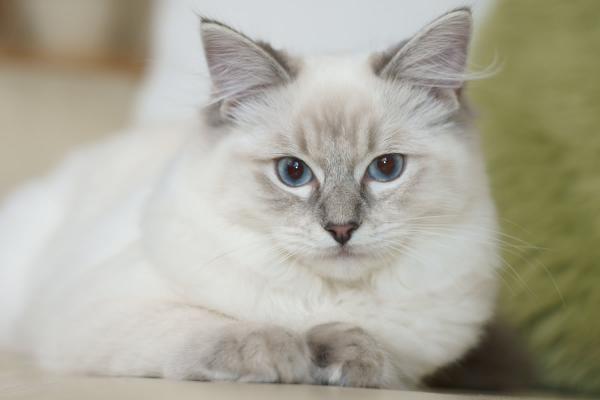Diseases of the ragdoll cat

The ragdoll cats They belong to a race of giant cats that originates in the United States, from various crosses among other races, such as the Persian, the Siamese and the sacred of Burma. In recent decades, these felines have become very popular as pets, for their remarkable beauty and temperate behavior. They’re cats Loyal and affectionate They establish a very special bond with their guardians and they need company to lead a healthy and happy life.
In general, the ragdoll cats have a very good health and have a longevity that is around the 10 years. However, they need to receive adequate preventive medicine and essential care to preserve their good health and maintain a balanced behavior.
In you will find information about the basic care of ragdoll, but this time we invite you to know ragdoll cat diseases so you can provide an optimum quality of life to your feline companion. Keep reading!
Inbreeding in ragdoll cats
La inbreeding can be defined as the mating of individuals who are genetically related (between siblings, between parents and children or between grandchildren and grandparents, for example). These crosses can occur spontaneously in nature, such as between mountain gorillas, bees and cheetahs, or be induced by humans. Unfortunately, inbreeding has been used as a resource during the creation process and / or standardization of races in domestic animals, mainly in dogs and cats.
In ragdoll cats, inbreeding is a serious problem, because around the 45% of your genes comes from a single founder, the Raggedy Ann Daddy Warbucks. Individuals born from inbreeding crosses present a low genetic variety, which makes them more likely to suffer a series of hereditary diseases and degenerative, also reducing their life expectancy.
In addition, these individuals may have a reduced success rate when reproducing. The inbred crosses usually generate smaller litters and the pups usually have a weaker immune system, which increases the mortality rate and reduces their chances of survival to give continuity to their species.
Cat radgoll diseases: obesity
Ragdoll cats are especially tame and enjoy a quiet lifestyle, are not exactly fans of a routine of intense physical activity. However, sedentary lifestyle is very detrimental to the health of these cats, because they can gain weight easily and show some symptoms of obesity in cats. Therefore, their tutors must not only offer a balanced diet, but also encourage them to practice exercise, games and stimulating activities on a regular basis.
Environmental enrichment is key to providing an environment that arouses your cat’s curiosity and “invites” you to play, exercise and expend energy. In addition, an enriched home is ideal to stimulate the cognitive, emotional and social capacities of your pussycat, thus preventing the symptoms of stress and boredom.
In we also teach you some passive exercises for cats, which will help you manage a healthy weight for your feline companion. Do not miss them!

Problems in the urinary tract of cats
The problems in the urinary tract They stand out as the most common ragdoll cat diseases, being able to affect the ureters, the urethra, the bladder and even expand to the kidneys. Among the most frequent urinary disorders in cats, we find the following pathologies:
Each of these diseases has its own symptoms, which will also depend on the state of health of the cat and the progress of the clinical picture. However, there are some signs that may indicate a condition in the urinary tract of cats, such as:
- Constant desire to urinate, but with difficulty expelling urine
- Lick intensely or constantly the genital area
- Pain when urinating
- Strength when urinating
- Presence of blood in the urine
- Urinary incontinence (the cat may begin to urinate outside the sandbox and even in totally unusual places, such as in their rest or toilet area)
Hair balls and digestive problems in ragdoll cats
Like most lake or semi-longhair cats, ragdoll can suffer from digestive problems resulting from the accumulation of hairballs in their stomach and intestinal tract. With their daily grooming habits, felines usually ingest some hairs when licking to sanitize their own body.
If the cat manages to effectively expel the hair, it should not suffer any alteration in its good health. However, when the kitten fails to purge properly, it may appear The following symptoms:
- General decay
- Apathy
- Frequent arcades
- Regurgitations
- Vomiting of liquid and food
To prevent the formation of hairballs in your pussycat’s digestive tract, it is essential brush regularly his fur to eliminate dead hair and dirt. To help you maintain the beauty and health of your ragdoll’s fur, we offer some tips for brushing a cat’s hair, and we’ll also show you how to choose the ideal brush for a long-haired cat.
In addition, malt for cats can be a safe and effective way to help your kitten to purge the hairs ingested in his daily grooming. In addition, it works as an excellent sensory stimulus for cats, allowing them to exercise physical and cognitive abilities.

Polycystic kidney disease
The polycystic kidney (or polycystic kidney disease) is a hereditary pathology Most frequently diagnosed in Persian and exotic cats with short hair, but which can also affect ragdoll.
In this clinical picture, the kidneys of the cat produce cysts that are filled with fluid from birth. As the cat grows, these cysts increase in size and can cause severe damage to the kidney, and even cause kidney failure.
Some of the Symptoms of polycystic kidney Feline can be:
- Loss of appetite
- Weight loss
- Weakness
- General decay
- Depression / lethargy
- High water consumption
- Frequent urination
La castration or sterilization of the cats that suffer from this pathology are crucial preventive measures to prevent the transmission of this disease and overpopulation, which in most cases end up in shelters or in the street itself.
Hypertrophic cardiomyopathy in ragdoll cats
Feline hypertrophic cardiomyopathy is the most common cardiac pathology in domestic felines and is also among the main ragdoll cat diseases. It is characterized by the Thickening of the myocardial mass of the left ventricle that causes a reduction in the volume of the cardiac chamber.
As a result, the feline’s heart becomes unable to pump blood correctly towards the other tissues and organs of the body. Then, complications related to poor circulation can appear, such as thromboembolism (formation of clots in different parts of the body that impair organic functions).
Although it can affect all cats, it is more common in cats elderly males. Its symptoms depend on the state of health of each cat and the progress of the disease, and there are also some asymptomatic cases. However, most characteristic symptoms of hypertrophic cardiomyopathy in cats are the following:
- Apathy
- Dyspnea breathing
- Vomiting
- Difficulty breathing
- Loss of appetite
- Weight loss
- Depression and lethargy
- Flaccidity in the hind limbs
- Sudden death

Visit your veterinarian
Now you know what are the most common ragdoll cat diseases, for that reason, do not forget the importance of preventing them by Veterinary visits every 6 or 12 months, monitoring the cat’s vaccination schedule and periodic deworming. In addition, before any symptom mentioned above or alteration in your behavior and routine, do not hesitate and go to your veterinarian, the only figure capable of ensuring the good health of your cat.
This article is merely informative, in .com we do not have the faculty to prescribe veterinary treatments or make any kind of diagnosis. We invite you to take your pet to the veterinarian in case of any type of condition or discomfort.
If you want to read more articles similar to Diseases of the ragdoll cat, we recommend that you enter in our section of hereditary diseases.


